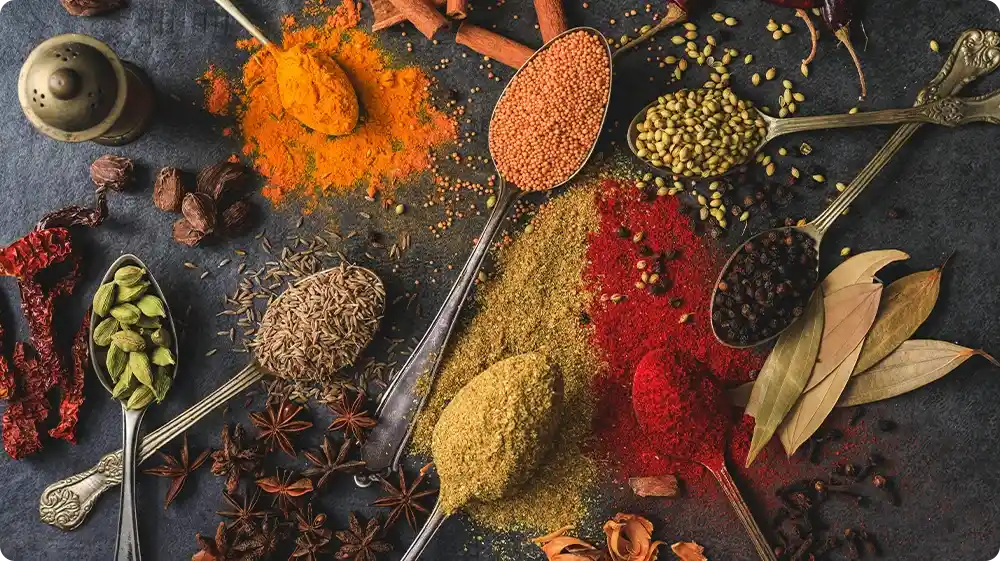Flavour plays a crucial role in every eating experience. Most of us have a basic understanding of what flavour is. We judge food by it, and we know something is delicious when it has the right one.
Flavour is what gives food its taste and keeps your customers coming back for more.
If you are a chef, run a restaurant or cafe, or work in catering, flavour is a big part of your everyday work. Getting it right can turn a good dish into a great one and help your business stand out.
This article is a quick and simple guide to understanding flavours.
What is Flavour?
As mentioned above, flavour is what gives your food its taste, but it is more than just taste; it’s the whole experience of eating. It’s the way your senses come together to help you enjoy food.
The moment you bite into something, your tongue picks up the basic tastes – sweet, salty, sour, bitter and umami. But your nose, too, is picking up all the subtle aromas that give food its character.
Flavour is also deeply tied to memory and emotion. It is why the smell of freshly baked bread might remind you of home, or why a well-seasoned Sunday roast with crispy roasted potatoes can take you back to a special family meal.
Flavour doesn’t just stay on your tongue, it lingers in your mind.

That is why two people can eat the same dish and have different opinions about it. One might call it comforting, while the other finds it overpowering. Flavour is personal, shaped by your background and mood.
Flavour is generally classified into three main types. Understanding them can help you design better menus, create more balanced dishes, and make smarter choices when reading labels. It can help you greatly when combined with a clear understanding of the Food Pyramid and how different food groups support a healthy diet.
Different Types of Flavour
Natural Flavours
These come from natural sources, such as fruits, plants, herbs, or animals. They may be extracted or concentrated, but they originate from natural sources.
- Examples: Lemon, vanilla, mint, or ginger.
- Often used in foods that want to keep a “clean label” or natural appeal.

Artificial Flavours
These are made in labs to copy the natural flavours and sometimes to create new ones. They are safe to eat and are often used because they are cost-effective.
- Examples: Flavours like strawberry, banana, or chocolate that are created without using the actual fruit or base ingredient.
- Often used in sweets, soft drinks, and packaged snacks.

Spices and Herbs
These are ingredients that add flavour on their own, they are not made in a lab or added as extras. They come from plants and are used in various cooking methods to add depth and aroma.
- Examples: Black pepper, basil, rosemary, cumin, thyme.
- Used fresh or dried, ground or whole, in both home and commercial kitchens.

Why is Flavour Important?
Flavour is much more than just a part of food. It’s at the heart of the eating experience. It is what makes a dish stand out. You might forget what was on the plate, but you’ll remember how it tasted.
The flavours you use decide how your dish will come together, whether it falls flat or leaves a lasting impression. Flavour connects to memory, mood, and personal experience.
One flavourful bite can remind someone of home, a special event, or even a holiday abroad.
Why Flavour Matters to Businesses and Customers?
In today’s competitive food industry, flavour does more than just please the palate; it plays a decisive role in building customer loyalty and shaping your brand.
- Flavour brings customers back – people often return to a restaurant, café or takeaway not just for the setting but because something in the taste stays with them.
- It builds emotional connection – a flavourful dish can trigger nostalgia, comfort, or joy, and that’s what turns first-time diners into loyal regulars.
- It is the foundation of authenticity – customers remember food that tastes real, rich, and unique. Flavour is what makes your offering stand out in the market.
- Flavour influences trends – pairing unexpected ingredients or creating bold new combinations can set trends, like the recent viral “pink sauce” wave across the U.K., which gained traction for its unique blend of creamy, tangy, and spicy flavours.
Customers today are looking for more than just taste in a brand. They care about the story behind the plate.
They notice things like whether your ingredients are sourced responsibly, whether your team is treated fairly, and how your food is made, whether it is crafted with care or rushed and artificial.
Even the little things matter.
The way your packaging looks and feels, the aroma that greets them before the first bite, and the texture that completes the experience. These details help shape how your food is remembered, but ultimately it’s the flavour that truly brings them back.
To see how this works in practice, let’s look at a real-world example of how a business used flavour innovation to meet both health goals and customer expectations.
Case Study: Kerry Group’s Flavour Innovation in Reduced-Sodium Snacks
Kerry Group successfully developed cheese-flavoured savoury snacks with reduced sodium content, targeting markets in Mexico and the USA. By utilising their Tastesense™ Salt technology, along with fermentation and Smoke & Grill techniques, they maintained the authentic cheese flavour while adhering to health guidelines.
Key Highlights:
✅ Sodium Reduction: Achieved up to 60% reduction in sodium without compromising on flavour.
✅ Flavour Preservation: Maintained the desired cheese flavour profile by using the advanced flavour-preserving technologies.
✅ Market Compliance: Aligned with health regulations in target markets.
📖 Source: Kerry Group Case Study
This case study exemplifies how businesses can innovate in flavour to meet health objectives without sacrificing consumer satisfaction.
Understanding Flavour Profiles
Understanding your customers’ flavour preferences is an essential part of delivering a great food experience. And that starts with the understanding of flavour profiles – the combinations of tastes and aromas that define a dish, a cuisine, or even a culture.
Flavour profiles help us recreate tastes from around the world and build dishes that are rich, layered, and memorable. These profiles often reflect regional habits and preferences of what grows locally, what’s been passed down through generations, and what people have come to love over time.
Understanding flavour profiles like this can help you do more than just replicate a dish, it enables you to pair ingredients smartly, adapt recipes to suit your customers’ tastes, and even innovate with confidence while staying true to a culinary tradition.
Flavour is what brings people together – across tables, cultures, and memories.
Different cultures have perfected their own unique blends of taste and aroma over centuries, giving us iconic flavour pairings that are loved worldwide.
Here are some well-known cuisines from around the world and the unique flavour combinations that make them stand out.
Global Flavours: What Makes Each Cuisine Unique
Thai – Thai cuisine is known for its vibrant contrast of sweet, salty, sour, and spicy. Think lemongrass, lime, chilli, and fish sauce — all working together to hit every part of your palate.
Mexican – Smoky chipotle, earthy cumin, zesty lime, and fresh coriander make up the backbone of bold and layered Mexican flavours.
Indian – Spices like cumin, coriander, turmeric, and cardamom are layered carefully to create depth and warmth, with balance coming from yoghurt, tomato, or citrus.
Japanese – Clean and delicate, Japanese food relies on umami-rich ingredients like miso, soy sauce, seaweed, and dashi, often balanced with subtle sweetness or acidity.

These combinations show just how much thought and tradition go into getting flavour right. And that brings us back to why flavour matters, it’s not just about making something taste good, it’s about creating an experience people remember.
FAQs
What’s the difference between flavour and taste?
Taste is what your tongue senses – sweet, sour, salty, bitter, and umami. Flavour includes taste, smell, texture, and even memory and emotion. Many people use the words ‘flavour’ and ‘taste’ interchangeably, but in food training, it’s important to distinguish them, just like how we differentiate between cross-contamination and cross-contact.
What makes food taste more flavourful?
Using fresh ingredients, proper seasoning, and balancing tastes like sweet, sour, and salty can make food more flavourful.
How does flavour work?
Flavour works through a mix of taste, smell, and texture. When you eat, your brain combines all these signals to create the flavour experience.
What are the main components of flavour?
Taste, aroma (smell), and mouthfeel (texture) are the key components of flavour.
Why is flavour important in food preparation?
Flavour makes food enjoyable, helps build customer loyalty, and sets your dish or brand apart.
What is umami?
Umami is a savoury taste often described as meaty or broth-like. It is one of the five basic tastes and adds depth to many dishes.
What is aroma?
Aroma is the smell or fragrance of food that greatly influences how we perceive flavour. It is detected by the nose and plays a key role in the overall eating experience.
What does mouthfeel mean?
Mouthfeel refers to the texture and physical sensations of food in the mouth, such as creaminess, crunchiness, or smoothness, which contribute significantly to flavour perception.





